This post may contain affiliate links at no additional cost to you. As an Amazon Associate I earn from qualifying purchases. Click to view our full disclosure.
What's inside
If you are looking to reduce inflammation, you’ve come to the right place.
While the body needs some inflammation to function properly, the problem arises when there is too much inflammation for the body to handle.
Too much inflammation can lead to a poor immune system, problems in gut health, trouble losing weight, and increased joint pain.
And how do I know? I’ve been there.
Once I figured out which foods made the condition better (or worse), I was able to reclaim my health.
That is why, as a Registered Dietitian, my main approach is to help my clients reduce inflammation.
Starting a meal plan might be overwhelming, but don’t worry! I’ve created a 21 day anti-inflammatory diet PDF for you to download for free. You’ll get the recipes, grocery list, and everything you need to get started.
Before we start, remember that a tailored meal plan will always be the best approach. With a tailored meal plan, you’ll get the exact calories you need based on your goals, needs, and activity levels.
So, whenever possible, talk with a health professional for personalized guidance.
What is an anti-inflammatory diet?
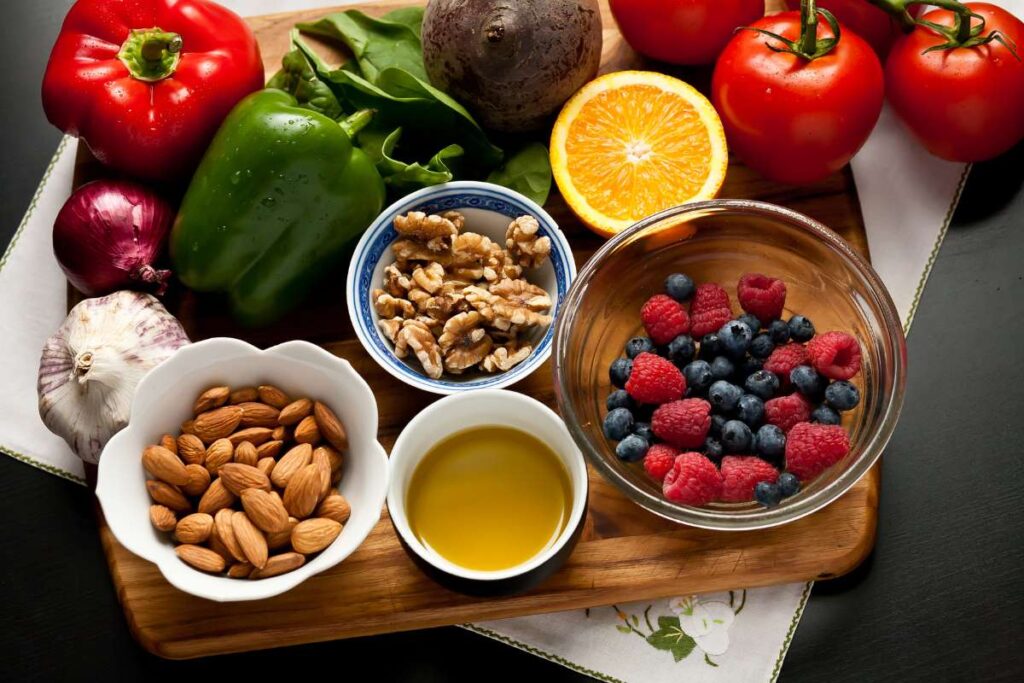
An anti-inflammatory diet focuses on vegetables, whole grains, fruits, healthy fats, and lean proteins. These are a good source of vitamins, antioxidants, and omega-3 fatty acids, all of which can help reduce inflammation.
On the other hand, it reduces pro-inflammatory foods like processed foods, sugary foods, high saturated fats, and fried foods.
How can food reduce inflammation?
Free radicals are unstable molecules that cause damage. These are created due to stress, poor diet, or smoking.
Due to the high antioxidant intake, the right diet can help reduce the effect of free radicals, which only cause more inflammation.
Antioxidants help make free radicals stable again, decreasing the damage they can do.
While the body naturally produces antioxidants, when the free radical content is too high for the body to manage, dietary antioxidants can give that extra support.
What are the different types of anti-inflammatory diet?
There are several approaches to help reduce inflammation: Mediterranean, paleo, plant-based, gluten-free, low-glycemic index, and autoimmune disease diets.
In the end, they have the same structure. This means having a diet high in natural foods like fruits, vegetables, whole grains, lean protein, and healthy fat.
What varies are the foods you include in each one.
And the benefit of them is that you can make your own diet based off of a combination of two or three of these. For example, you can follow a gluten-free and plant-based diet. It all depends on your goals and preferences.
Let’s take a closer look at each diet.
Mediterranean Diet
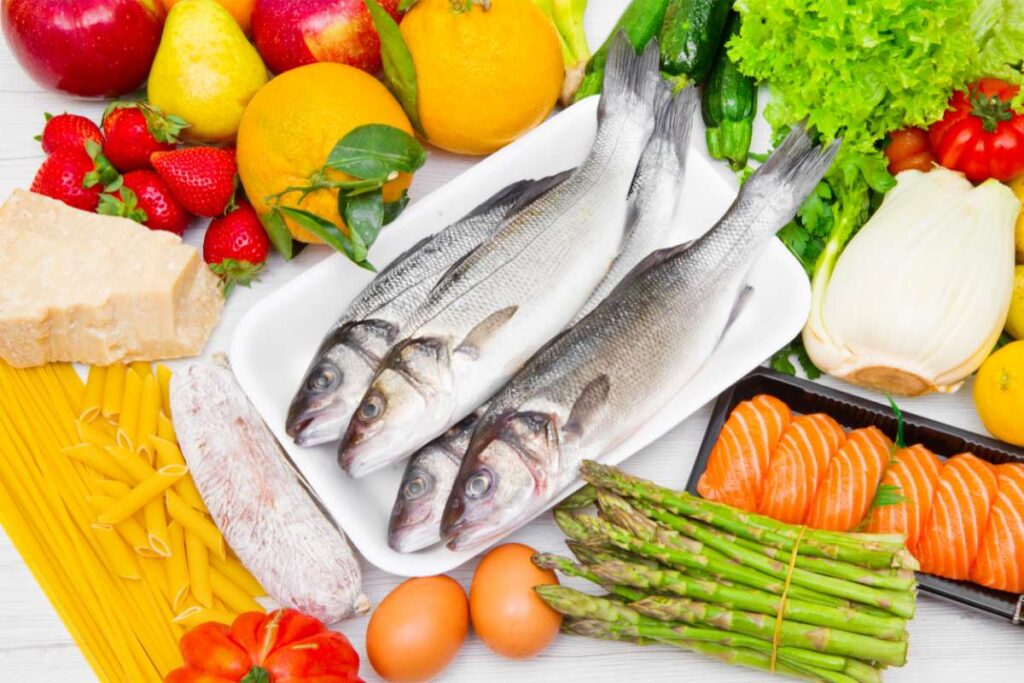
The Mediterranean diet is based on the eating pattern of countries bordering the Mediterranean Sea, such as Spain, Greece, Italy, and France.
Research shows that people in these areas tend to have good health and a reduced risk of chronic illnesses.
The diet follows the same principle as any anti-inflammatory diet. It encourages the consumption of fruits, vegetables, whole grains, nuts, seeds, legumes, low-fat proteins, and healthy fats.
One of the things that makes this diet different from the rest is that it allows the consumption of red wine in small quantities. Evidence suggests that red wine is high in resveratrol, a strong antioxidant that can help reduce inflammation.
Paleo Diet
The Paleo diet is based on how our ancestors used to eat.
This means no processed foods, since our ancestors didn’t have chocolate chip cookies in their diets. Instead, you eat more fresh ingredients like eggs, lean protein, fruits, nuts, seeds, herbs, spices, and healthy fats.
Some foods it decides to limit are legumes and dairy products.
According to research, the paleo diet and the Mediterranean diet have some of the highest scores with reduced inflammation biomarkers.
Plant-Based Diet
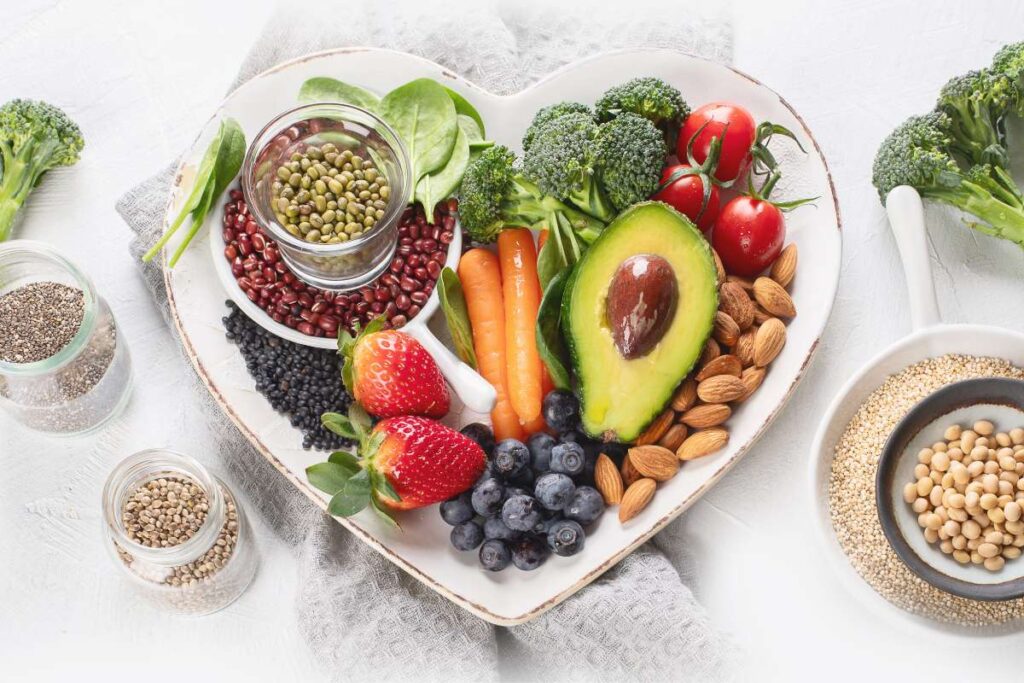
A plant-based diet focuses on including mostly plant-based products instead of animal products.
There are several approaches to a plant-based diet. It can mean someone who eats certain animal products (vegetarians) or someone who fully avoids them (vegans).
Research shows that consuming a plant-based diet can boost nutrient and fiber intake, which helps reduce inflammation.
Gluten-Free Diet
Gluten is a protein found in wheat, rye, barley, and spelt.
So, anything made from any of these products is a high-gluten food. For example, cookies, pasta, bread, and cakes are mostly baked with wheat flour.
Some people seem to have unwanted gastrointestinal problems when eating high-gluten foods. Research shows that you don’t have to be celiac to present side effects or inflammation.
A study showed that high gluten consumption increased the risk of inflammatory biomarkers and gut permeability (leaky gut).
Additionally, one of the benefits of a gluten-free diet is that the products that replace gluten-containing foods are typically anti-inflammatory. For example, a gluten-free alternative is chia seed flour, which is higher in omega-3 fatty acids than white flour.
Low-Glycemic Diet
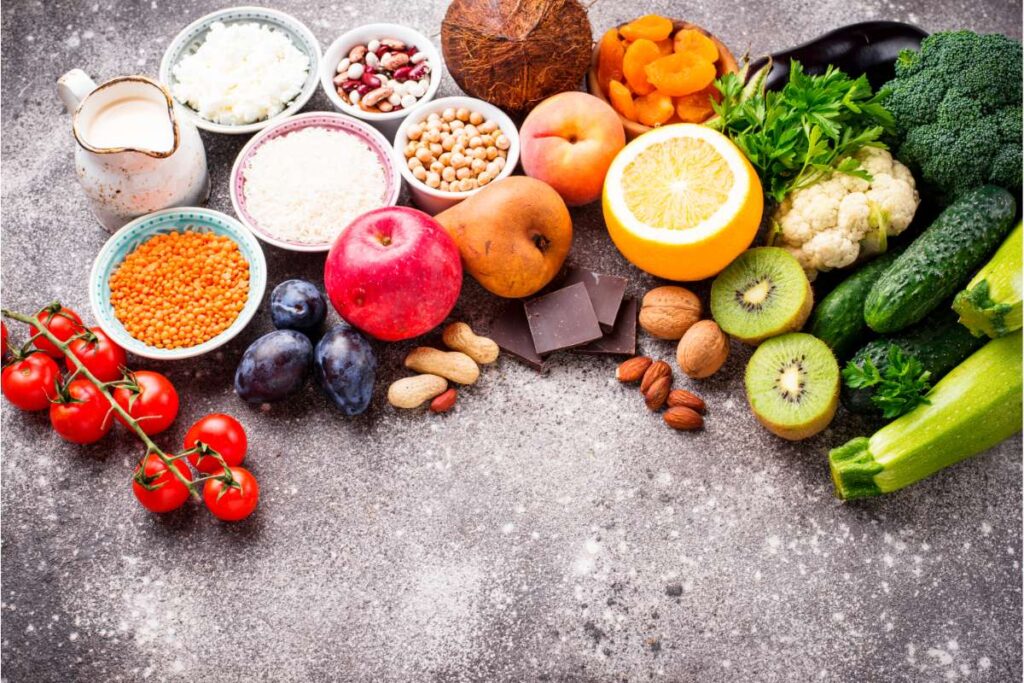
The glycemic index is a measurement of the impact of a food on sugar levels.
When the body digests carbs, it breaks them down into simple sugars. The easier it is for the body to process the food, the higher the sugar response. This means that the higher the glycemic index.
A low-glycemic diet follows the idea of only eating foods that have a low sugar response. This means avoiding processed foods and eating whole grains, vegetables, legumes, and some fruits.
A 2018 study showed that students who focused on consuming a low-glycemic index diet had lower inflammatory markers.
So, it seems that following a low-glycemic index can have a positive effect on inflammation.
Autoimmune Diseases Diet
Finally, the autoimmune disease diet (AIP), looks to reduce inflammation caused by inflammatory auto-immune diseases like lupus, inflammatory bowel disease, and arthritis.
While there is still more information in this topic, it seems that leaky gut, a condition where you have more permeable intestinal walls, can increase the risk of inflammatory autoimmune disease.
The problem is that when the intestinal walls are more permeable, it can lead to bacteria, toxins, and other harmful molecules to enter the body.
With that said, the autoimmune disease diet focuses on removing foods that can increase intestinal permeability.
One of the biggest differences in the AIP diet from the other diets, is that you need to follow an elimination process. Here, you eliminate several foods like nightshade vegetables (like eggplant), eggs, dairy, legumes, nuts, and grains.
This stage only lasts 30 to 90 days.
After the elimination phase, you slowly start introducing foods again, always paying attention to any possible symptoms.
3 Tips for Following the 21 Day Anti-Inflammatory Diet Meal Plan
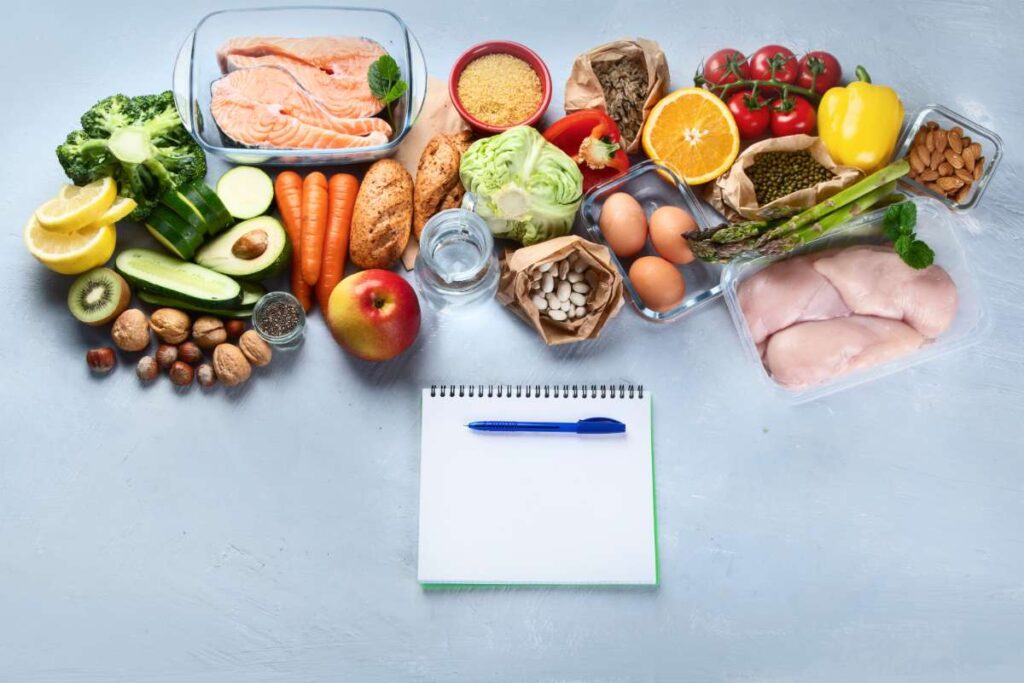
Starting a new meal plan might sound overwhelming.
Big changes can be scary, especially if you don’t know how or where to start. But, don’t worry! I have three tips that help my clients ease into any meal plan.
Meal Prepping
Meal prepping sounds like a lot of work. But the truth is, it doesn’t have to be. Meal prep is there to make your life easier by saving you time and money.
The other good thing about meal prep is that you can adjust it to your needs. For example, most people think that meal prepping means cooking ALL the meals in advance.
And, yes, that can be one type of meal prep.
Other types of meal prep just involve washing and preparing the fruits and vegetables or making the snacks in advance. You could even simply cut up and portion out all the ingredients you will use in each recipe.
The sky’s the limit when it comes to meal prepping.
How To Meal Prep
- Choose your menu. After reading the recipes from the meal plan, list what you want to prepare in advance. Remember that it can be whole meals you want to make in advance or only certain ingredients (cooking a batch of brown rice).
- Make a list of the extra items you need. Write down all the kitchen utensils you are going to need, such as containers, jars, scales, and any other thing to make meal prepping easier.
- Pick a day. Select when and at what time you are going to meal prep. Place it in your calendar so you don’t forget!
- Get your groceries. Grab the grocery list and go shopping. Make sure you never go on an empty stomach since it can increase the risk of adding food that can cause inflammation (like chips or cookies).
- Prepare and portion. Once you have everything ready, start making the meals. When you have everything cooked and ready, put each serving in its own container for portion control.
Making Changes To Your Meal Plan
Adjusting your meal plan to fit your life can make it easier to follow.
Keep in mind that if you are making changes, stick with the foods you are recommended to reduce inflammation. Including foods that are not on the list can affect your results.
Also, make sure to make the changes within the same food group.
For example, you can switch one vegetable for another one. You can also replace brown rice with sweet potato since they are both starches.
However, you cannot replace mushrooms (non-starchy vegetables) with potatoes (starchy vegetables).
You can also switch meals on the same day. For example, you can have the lunch recipe for dinner. Or, you have the morning snack in the afternoon and the other way around.
But don’t make changes from different days. For example, having lunch from the Monday option for dinner on Thursday. This can change the calorie and macronutrient composition.
Other Lifestyle Changes To Reduce Inflammation
Nutrition is not the only thing that can affect inflammation. There are other lifestyle changes that go hand-in-hand with nutrition.
Here are some factors you need to consider when implementing an anti-inflammatory diet.
- Reduce stress levels. Practicing yoga, meditation, and mindfulness can help.
- Exercise. Make sure you do at least 150 minutes of light to moderate weekly exercise. Movement is also important. For example, if you have a desk job, try to move every hour for one to two minutes.
- Have some rest days. Intense exercise can increase inflammation, especially if you don’t give your body enough time to recover.
- Reduce alcohol intake and stop smoking.
- Get a good night’s sleep. Strive for seven to eight hours of high-quality sleep every night.
Macro Calculator
The meal plan below provides 1,600 calories daily, which isn’t right for everyone. It all depends on your goals, needs, and activity levels.
While a health professional can tailor a meal plan based on your needs, not everyone has access to one.
If that is the case, a calorie and macro calculator can give you an idea of how many calories you need to reach your goal.
There are hundreds of calorie calculators out there, but we recommended our calorie and macro calculator since it is backed up by scientific evidence. The best part is that it is easy to use.
- Select your training and nutrition experience: Beginner, moderate, or expert.
- Select your tracking experience: Beginner, moderate, or expert.
- Tell us your age, weight, height, and fat percentage (optional).
- Select your activity levels: Sedentary, lightly active, moderately active, heavily active, or athlete.
- Get your results!
Foods To Consider When Deciding on the 21-Day Anti-Inflammatory Diet

Anti-inflammatory foods are high in nutrients, antioxidants, and healthy fats, like omega-3 fatty acids. They can be a combination of all the things mentioned or just contain one or two.
The point is to try to add as many healthy whole foods as possible.
- Whole grains: Brown rice, lentils, chickpeas, and quinoa.
- Vegetables: Leafy greens, broccoli, cauliflower, mushrooms, and bell peppers.
- Healthy fats: Avocado, olive oil, and flaxseed oil.
- Nuts and seeds: Peanuts, almonds, cashews, hemp seeds, and chia seeds.
- Proteins: Salmon, sardines, mackerel, anchovies, shrimp, chicken, tuna, and turkey.
- Fruits: Strawberries, blackberries, raspberries, blueberries, pomegranates, cherries, and apples.
- Spices: Turmeric, fenugreek, and cinnamon.
Remember that the more variety you have in your diet, the more nutrients you get and the easier it will be to fight inflammation.
Anti-Inflammatory Foods List PDF
If you are looking for a more detailed list of the foods you should include to help reduce inflammation, I’ve got your back.
The following PDF is free for you to download. It’s an extensive list of anti-inflammatory foods to have handy everywhere you go.
Free anti-inflammatory foods list PDF:
Fruits
- Apples
- Apricots
- Bananas
- Blueberries
- Cherries
- Cranberries
- Grapefruit
- Grapes
- Kiwi
- Lemons
- Lime
- Mandarin oranges
- Mango
- Oranges
- Papaya
- Peaches
- Pear
- Pineapple
- Pomegranate
Vegetables
- Arugula
- Asparagus
- Bamboo shoots
- Bell pepper
- Broccoli
- Brussels sprouts
- Cabbage
- Carrots
- Cauliflower
- Celery
- Cucumber
- Eggplant
- Garlic
- Green beans
- Kale
- Leeks
- Mushrooms
- Onions
- Spinach
- Summer squash
- Swiss chard
- Tomatoes
- Watercress
- Zucchini
Legumes
- Beans (any type)
- Chickpeas
- Edamame
- Lentils
Nuts and seeds
- Almonds
- Brazil nuts
- Cashews
- Chia seeds
- Flax seeds
- Hazelnuts
- Hemp seeds
- Macadamia nuts
- Peanuts
- Pecans
- Pistachios
- Pumpkin seeds
- Sesame seeds
- Walnuts
Proteins
- Anchovies
- Cheese (low-fat)
- Chicken
- Dairy (low-fat)
- Mackerel
- Salmon
- Sardines
- Trout
- Tuna
- Turkey
Healthy fats
- Avocado
- Avocado oil
- Nuts
- Seeds
- Olives
- Olive oil
Whole grains
- Barley
- Brown rice
- Buckwheat
- Farro
- Millet
- Oats
- Quinoa
- Sorghum
- Whole rye
- Whole wheat
Herbs and spices
- Allspice
- Black pepper
- Cayenne pepper
- Cloves
- Cocoa powder
- Coriander
- Cinnamon
- Cumin
- Dill
- Ginger
- Fennel
- Marjoram
- Mint
- Parsley
- Oregano
- Rosemary
- Saffron
- Sage
- Tarragon
- Turmeric
Inflammatory Foods To Avoid

The following foods have been associated with an increased risk of inflammation.
If you’re actively trying to reduce inflammation, make sure you avoid the following:
- Refined carbs: White bread, white rice, and white pasta.
- Sweets: Candies, cookies, desserts, cake, and ice cream.
- Processed meats: Hot dogs, deli meat, sausages, bacon, and bologna.
- Processed oils: Vegetable oils like soybean and corn.
- Sugary beverages: Fruit juices, sodas, and sugary drinks.
- Processed snacks: Chips, pretzels, and crackers.
- Alcohol (in large quantities).
Now, does it mean you need to eliminate these foods completely?
No.
You can include them in a healthy lifestyle if you include them in moderation.
Also, not all processed foods (chips, crackers, and cookies) are bad. It all depends on the ingredients used. One recommendation I tell my clients is that if an ingredient list reads like a scientific experiment (with foods you cannot even pronounce), it’s better to avoid it.
But, if it’s a food you have in your pantry with a short list of ingredients, it’s ok to have.
The 21-Day Anti-Inflammatory Diet Meal Plan PDF
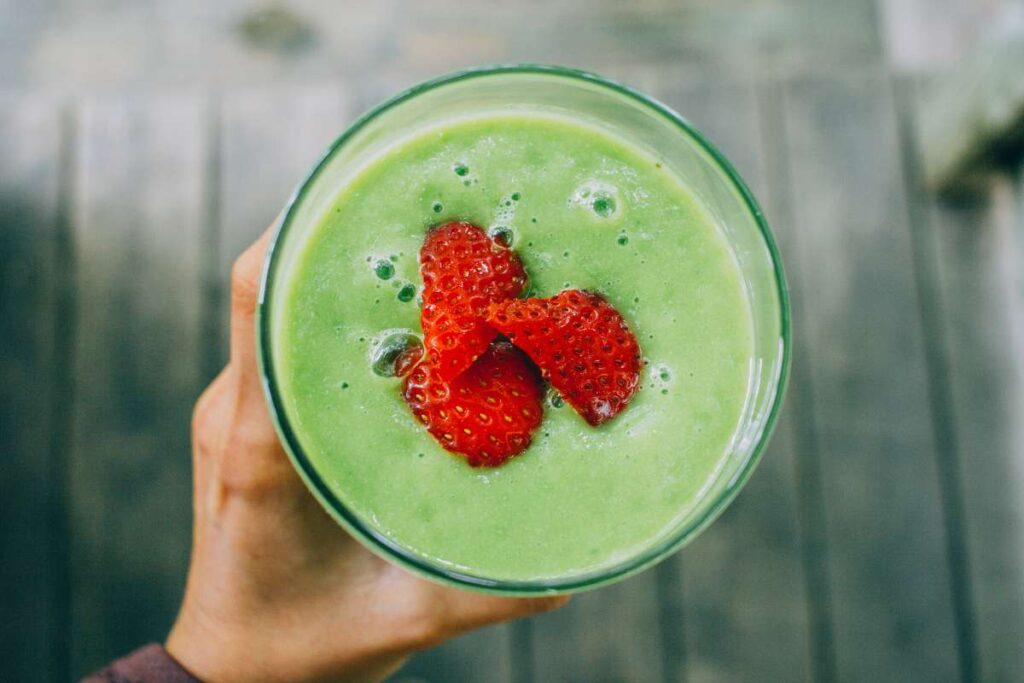
The following meal plan is based on 1,600 calories with a macro distribution of 40% carbs, 30% proteins, and 30% fats.
Remember that this is just a recommendation.
If you want a personalized meal plan, talk with a health professional to get a diet with the right calories for your needs.
Here’s a preview of the meals in the first week of the 21-day anti-inflammatory meal plan.
If you want the rest of the meals, the full recipes, and the grocery list, you can download it for free from the link at the end.
Monday
- Breakfast: Eggs and sauerkraut
- Snack: Mackerel salad open-faced sandwich
- Lunch: Salmon, rice, and arugula
- Snack: Cottage cheese and mashed banana
- Dinner: Baked cod with veggies and quinoa
Tuesday
- Breakfast: Eggs and sauerkraut
- Snack: Mackerel salad open-faced sandwich
- Lunch: Baked cod with veggies and quinoa
- Snack: Cottage cheese and mashed banana
- Dinner: Pressure cooker chicken taco stuffed sweet potato
Wednesday
- Breakfast: Eggs and sauerkraut
- Snack: Mackerel salad open-faced sandwich
- Lunch: Pressure cooker chicken taco stuffed sweet potato
- Snack: Cottage cheese and mashed banana
- Dinner: Cucumber soba noodles with tempeh
Thursday
- Breakfast: High-protein peanut butter oatmeal
- Snack: Eggs, cottage cheese, and microgreens with homemade salsa
- Lunch: Cucumber soba noodles with tempeh
- Snack: Creamy tuna on oat crackers
- Dinner: Coconut cod tacos
Friday
- Breakfast: High-protein peanut butter oatmeal
- Snack: Eggs, cottage cheese, and microgreens with homemade salsa
- Lunch: Coconut cod tacos
- Snack: Creamy tuna on oat crackers
- Dinner: Pressure cooker butter chicken
Saturday
- Breakfast: Warm peas with eggs
- Snack: Eggs, cottage cheese, and microgreens with homemade salsa
- Lunch: Pressure cooker butter chicken
- Snack: Creamy tuna on oat crackers
- Dinner: Pineapple chicken tacos
Sunday
- Breakfast: Warm peas with eggs
- Snack: Eggs, cottage cheese, and microgreens with homemade salsa
- Lunch: Pineapple chicken tacos
- Snack: Creamy tuna on oat crackers
- Dinner: Lemon Dijon chicken with rice
To download the free 21-day anti-inflammatory diet recipes and grocery list, click on the following links:
- 21-Day Anti-Inflammatory Diet Week 1 PDF
- 21-Day Anti-Inflammatory Diet Week 2 PDF
- 21-Day Anti-Inflammatory Diet Week 3 PDF
Benefits of Meal Prepping
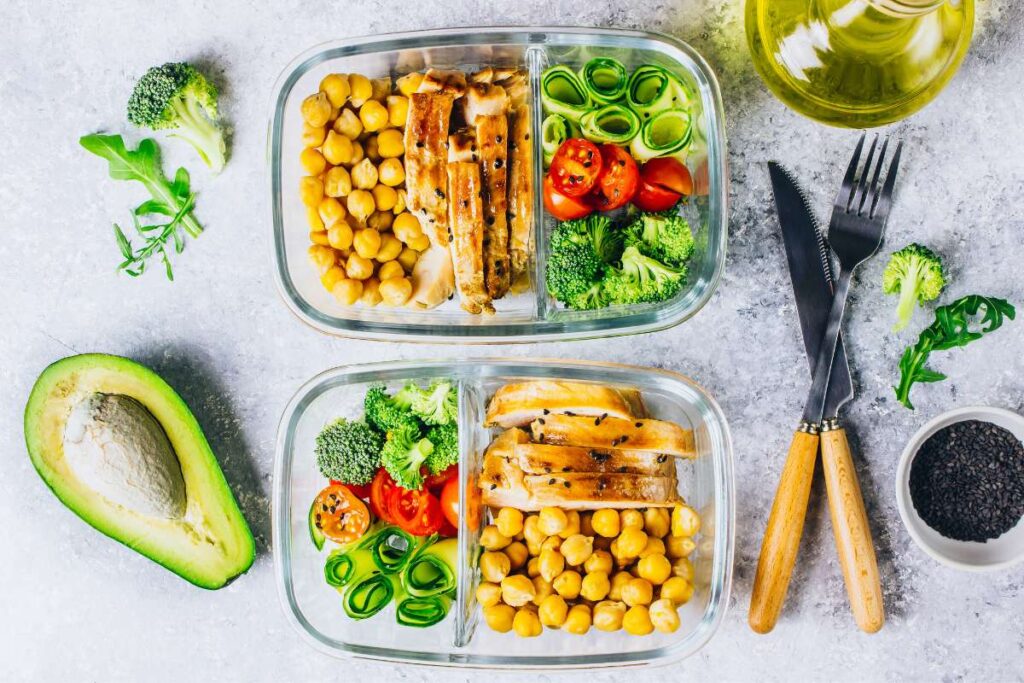
Now that we’ve seen what delicious recipes you get for this 21 day anti-inflammatory meal plan, let’s drill down on why meal prepping is the way to go.
Saves Time and Money
When you know what you need to prepare ahead of time, you won’t spend extra money on takeout or whatever you see at the store.
And since your menu is done and you may cook things all at once, you don’t need to spend hours in the kitchen every day.
Additionally, you can batch-cook recipes, which helps you save money since you buy in bulk. Also, waste can be significantly reduced when you meal prep.
Helps You Stay On Plan
With meal prepping, you can come home after a long day of work and simply reheat a delicious meal. Forget about stressing over what to make or if you have the ingredients.
With less stress in your life, you won’t be as likely to resort to processed “comfort” foods.
On top of that, since you know what you are going to have, you don’t need to go through a drive-through to get a meal.
This helps you stay on plan by removing any excuses to choose unhealthy options.
Easier To Shop for Groceries
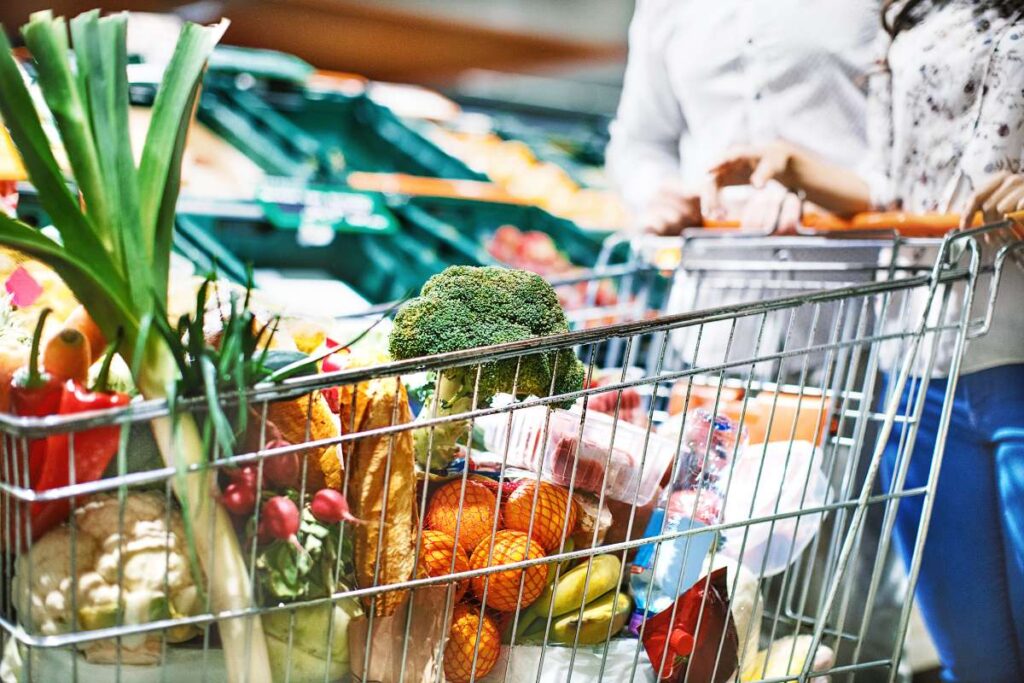
Going to the store without a complete list of healthy ingredients ruins diets. You question whether a food is healthy or not, or get distracted by tasty-looking foods you should avoid.
With a comprehensive list, you can avoid picking up any unwanted and unnecessary items. Plus, since the list is complete, you won’t be missing any items you’ll have to run back out for.
Portion Control
Finally, when you prepare meals in advance, it is easier to portion everything out. Once you cook the meal, store each serving in individual containers.
We often don’t know what a healthy portion looks like. And we’re not as likely to care if we’re hungry and filling up our plates on the spot.
If you portion out your food ahead of time, you’ll get better results.
Conclusion
That concludes my 21-day anti-inflammatory diet meal plan.
Planning meals so you always know what you are going to eat makes it easier to stay on course. Sticking to the meal plan can help you get better results since you are less likely to add outside foods that can increase inflammation.
Remember that a personalized meal plan is always going to give you the best results. A health professional adjusts the meal plan based on your goals, needs, preferences, and current health status.
If you cannot attend a professional consultation, you can get some guidance with our free calorie and macro calculator.
What are you waiting for to get back your health? After all, lower inflammation might be just one click away.
Frequently Asked Questions
How to reduce inflammation in the body fast?
To reduce inflammation add anti-inflammatory foods like fruits, vegetables, whole grains, lean proteins, and healthy fats. Avoid foods high in saturated fats, processed foods, sugary drinks, and deli meats. But remember that it might take some time to see the effects.
After all, how many years have you had inflammation?
What is the easiest anti-inflammatory diet?
The easiest anti-inflammatory diet is focusing on which foods to add or replace. Focus on adding whole grains, fruits, vegetables, healthy fats, and lean proteins. For example, switch regular rice with brown rice, and add more vegetables to the meal.
Can you eat eggs on an anti-inflammatory diet?
Yes, eggs are a source of high-quality protein. They also provide essential vitamins and minerals to keep the body healthy.
What is the fastest way to reduce inflammation in the body?
Reducing inflammation takes time, but making sure you eliminate any processed foods is the fastest way to ensure you are giving the body the nutrients it needs to help fight inflammation.
You can also add some turmeric to your meals to give them an extra anti-inflammatory boost.
What is a classic anti-inflammatory diet?
The Mediterranean diet is a classic anti-inflammatory diet. It focuses on eating lean protein, healthy fats, fruits, vegetables, and whole grains. All foods are high in antioxidants to help reduce inflammation.
What to take for inflammation?
There are some supplements you can take to reduce inflammation. Green powders, turmeric capsules, and CoQ10 are some examples of powerful antioxidants you can take to reduce inflammation.
However, before adding a supplement, check with your doctor.
What foods are inflammatory?
Processed foods, fried foods, sugary drinks, high saturated fats, and deli meats are all inflammatory foods. It’s best to avoid them if you are on an anti-inflammatory diet.


